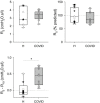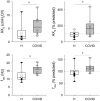Post-COVID changes in lung function 6 months after veno-venous extracorporeal membrane oxygenation: a prospective observational clinical trial
- PMID: 38173937
- PMCID: PMC10761408
- DOI: 10.3389/fmed.2023.1288679
Post-COVID changes in lung function 6 months after veno-venous extracorporeal membrane oxygenation: a prospective observational clinical trial
Abstract
Background: Severe coronavirus disease 2019 (COVID-19) may require veno-venous extracorporeal membrane oxygenation (V-V ECMO). While V-V ECMO is offered in severe lung injury to COVID-19, long-term respiratory follow-up in these patients is missing. Therefore, we aimed at providing comprehensive data on the long-term respiratory effects of COVID-19 requiring V-V ECMO support during the acute phase of infection.
Methods: In prospective observational cohort study design, patients with severe COVID-19 receiving invasive mechanical ventilation and V-V ECMO (COVID group, n = 9) and healthy matched controls (n = 9) were evaluated 6 months after hospital discharge. Respiratory system resistance at 5 and 19 Hz (R5, R19), and the area under the reactance curve (AX5) was evaluated using oscillometry characterizing total and central airway resistances, and tissue elasticity, respectively. R5 and R19 difference (R5-R19) reflecting small airway function was also calculated. Forced expired volume in seconds (FEV1), forced expiratory vital capacity (FVC), functional residual capacity (FRC), carbon monoxide diffusion capacity (DLCO) and transfer coefficient (KCO) were measured.
Results: The COVID group had a higher AX5 and R5-R19 than the healthy matched control group. However, there was no significant difference in terms of R5 or R19. The COVID group had a lower FEV1 and FVC on spirometry than the healthy matched control group. Further, the COVID group had a lower FRC on plethysmography than the healthy matched control group. Meanwhile, the COVID group had a lower DLCO than healthy matched control group. Nevertheless, its KCO was within the normal range.
Conclusion: Severe acute COVID-19 requiring V-V ECMO persistently impairs small airway function and reduces respiratory tissue elasticity, primarily attributed to lung restriction. These findings also suggest that even severe pulmonary pathologies of acute COVID-19 can manifest in a moderate but still persistent lung function impairment 6 months after hospital discharge.
Trial registration: NCT05812196.
Keywords: ECMO; plethysmography; post-COVID-19; respiratory failure; respiratory oscillometry; spirometry.
Copyright © 2023 Pálfi, Balogh, Polónyi, Schulcz, Zöllei, Bari, Fodor, Baráth, Somfay, Peták and Babik.
Conflict of interest statement
The authors declare that the research was conducted in the absence of any commercial or financial relationships that could be construed as a potential conflict of interest.
Figures



References
-
- Sun P, Fanning J, Peeler A, Shou B, Lindsley J, Caturegli G, et al. Characteristics of delirium and its association with sedation and in-hospital mortality in patients with COVID-19 on veno-venous extracorporeal membrane oxygenation. Front Med. (2023) 10:1172063. 10.3389/fmed.2023.1172063 - DOI - PMC - PubMed
-
- Laghlam D, Charpentier J, Hamou Z, Nguyen L, Pene F, Cariou A, et al. Effects of prone positioning on respiratory mechanics and oxygenation in critically ill patients with COVID-19 requiring venovenous extracorporeal membrane oxygenation. Front Med. (2021) 8:810393. 10.3389/fmed.2021.810393 - DOI - PMC - PubMed
-
- Lorusso R, De Piero M, Mariani S, Di Mauro M, Folliguet T, Taccone F, et al. In-hospital and 6-month outcomes in patients with COVID-19 supported with extracorporeal membrane oxygenation (Euroecmo-COVID): A multicentre, prospective observational study. Lancet Respir Med. (2023) 11:151–62. 10.1016/S2213-2600(22)00403-9 - DOI - PMC - PubMed
Associated data
LinkOut - more resources
Full Text Sources
Medical

